Prepare for a colorful adventure as we explore the stunning world of West Virginia‘s most beautiful birds! Imagine walking through lush forests and peaceful meadows, listening to sweet melodies, and watching elegant dances in the sky. Whether you’re a birdwatcher or just love being outdoors, you’ll be amazed by the lovely feathered friends waiting to be discovered in West Virginia.
American Coot (Fulica Americana)
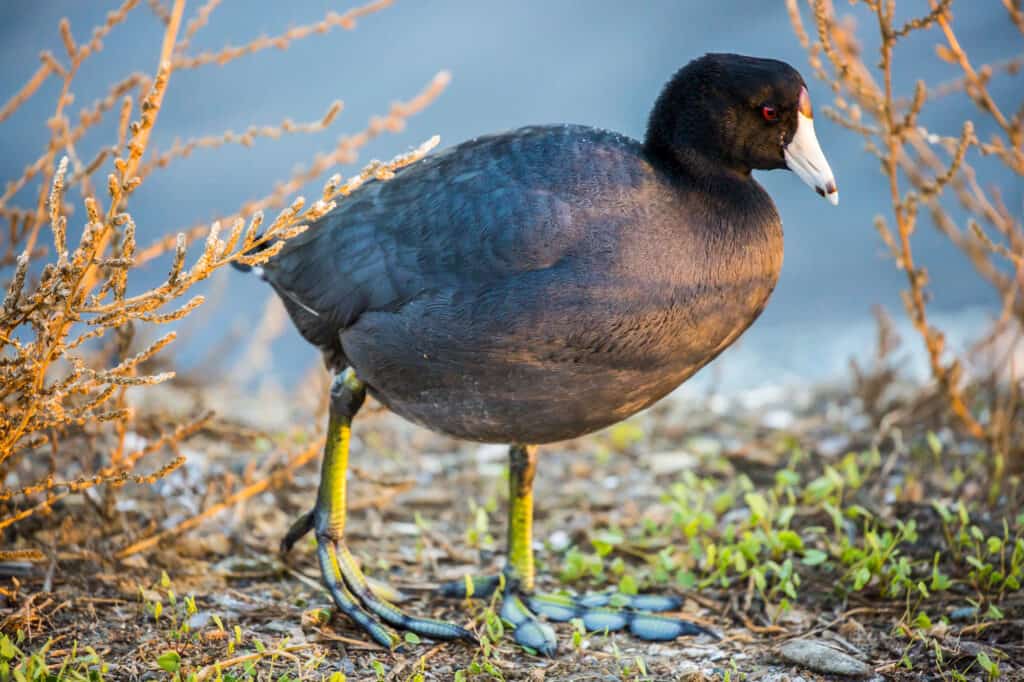
usually inhabits lakes, slow-moving rivers, and large freshwater ponds at lower elevations across West Virginia.
©yhelfman/Shutterstock.com
The American Coot is a migratory avian species endemic to the Nearctic area. It thrives in freshwater bodies all over the northern region of the United States, including West Virginia.
These birds possess distinctive physical characteristics such as red eyes, a white bill with a black tip, and a red patch on their forehead. Their bodies are of a dark grayish-black hue and have white patches below their small tails. Additionally, their legs are either greenish or yellowish.
American coots usually inhabit lakes, slow-moving rivers, and large freshwater ponds at lower elevations across West Virginia. Their diet includes fish, amphibians, and reptiles, and they also steal food from other birds.
Though they appear similar to ducks while swimming, American coots have unique feet that lack webbing. Instead, each toe segment has lobes on the side.
American Goldfinch (Spinus tristis)

The American goldfinch is known for its impressive flying skills, soaring high with a wave-like motion.
©iStock.com/Ronald Washington
In West Virginia, it’s not uncommon to spot these charming little finches sporting bright colors.
During spring and early summer, male American goldfinches flaunt a vibrant yellow hue with white patches beneath and above the tail, black wings with white markings, and a black forehead. Meanwhile, females tend to appear less colorful with an olive top and a dull yellow bottom. Their appearance changes during the winter as they become brown with two pale wing bars and blackish wings.
Measuring about 4.3 to 5.5 inches in length, the American goldfinch is classified as a small finch.
American goldfinches in West Virginia prefer to reside in floodplains and weedy fields with abundant plants such as asters and thistles. These lovely birds frequently visit bird feeders during the winter and prefer nyjer and sunflower seeds.
The American goldfinch has impressive flying skills, soaring high with a wave-like motion.
Belted Kingfisher (Megaceryle alcyon)
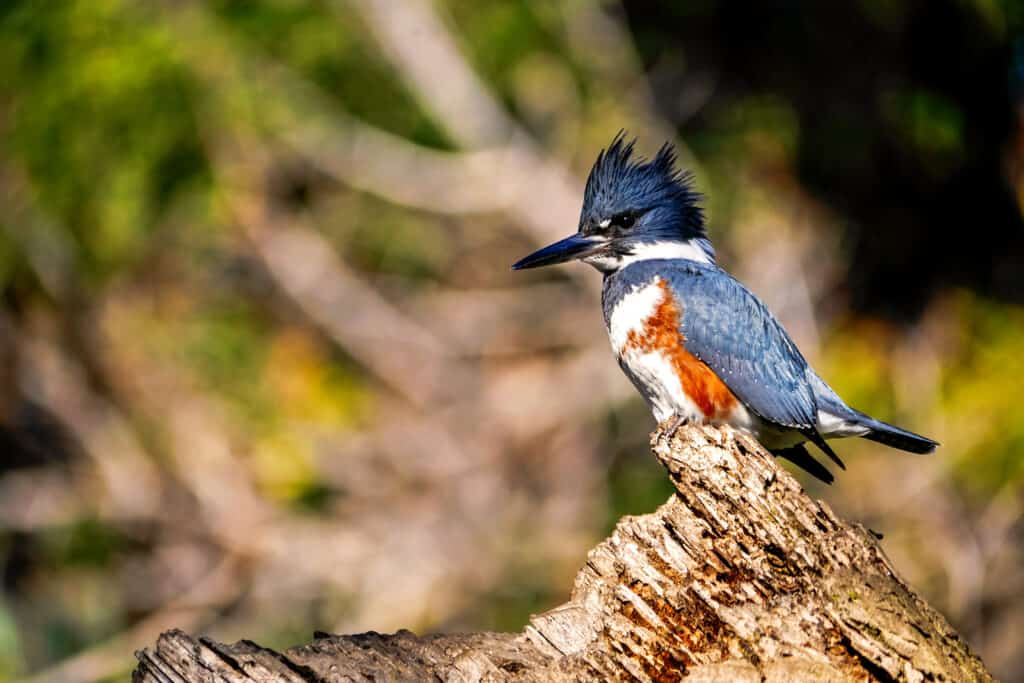
A stocky bird with a notable large head, the belted
kingfisher
has a wingspan of 19 to 33 inches.
©Horse Crazy/Shutterstock.com
The northern United States, including West Virginia, is home to a remarkable water bird known as the belted kingfisher. This bird is the sole representative of its water kingfisher group commonly found in the region.
A stocky bird with a notable large head, the belted kingfisher has a wingspan of 19 to 33 inches and can grow between 11 and 14 inches in length. The bird boasts a shaggy crest on its head, short legs, and a short thick bill.
Belted kingfishers prefer to live near bodies of water such as streams, rivers, ponds, lakes, and estuaries, where trees provide suitable perching points to spot fish from above. Its primary diet consists almost entirely of aquatic prey, which it catches by diving into the water.
The female belted kingfisher is more colored than the male.
Downy Woodpecker (Picoides pubescens)
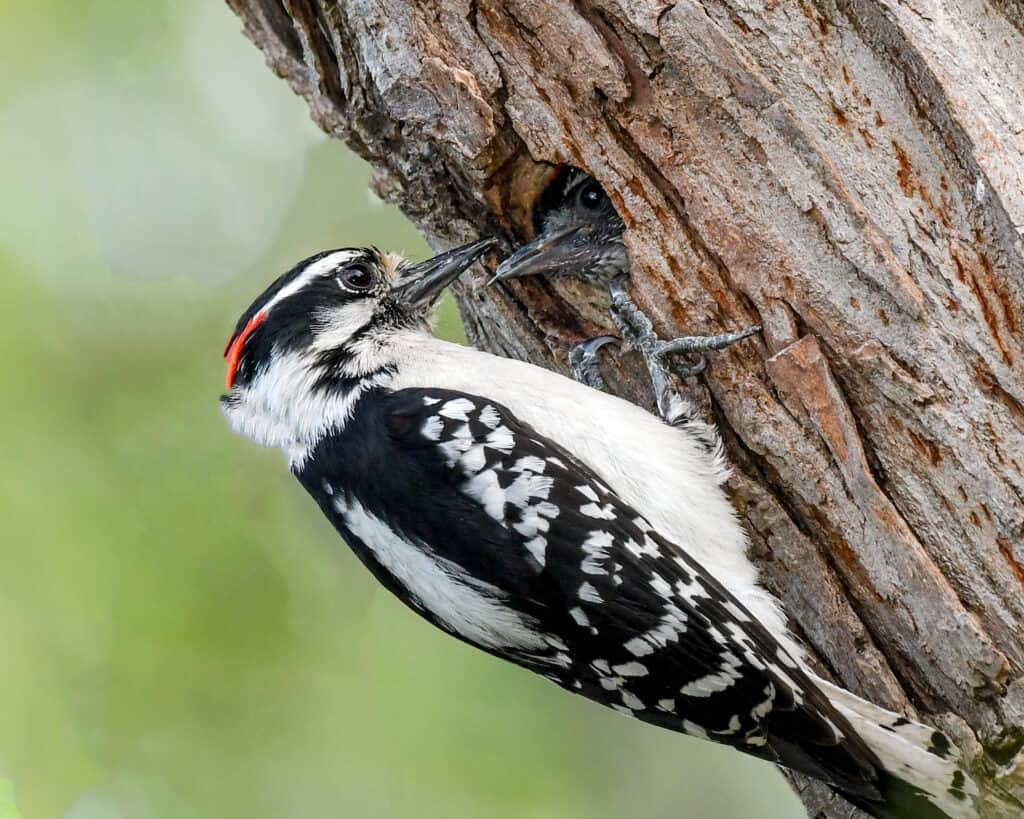
Being North America’s smallest
woodpecker
species, the downy woodpecker can create cavities in dead trees or limbs.
©Brent Barnes/Shutterstock.com
Downy woodpecker, characterized by its black-and-white checkered pattern, is a prevalent avian species in West Virginia. Its upper parts exhibit white and black markings on the wings, and its head features distinctive stripes. Additionally, a broad white stripe adorns its back. At the back of their heads, males feature a small patch of red color.
These woodpeckers are approximately 7 inches in size. They thrive in various habitats in West Virginia, including residential backyards, deciduous forests, and regions close to water sources. Their diet is omnivorous and comprises insects, seeds, berries, grains, sap, suet, and acorns from birdfeeders.
Being North America’s smallest woodpecker species, the downy woodpecker can create cavities in dead trees or limbs. These cavities can be around 6 to 8 inches deep and 1.5 to 2 inches in diameter at the entrance.
Tufted Titmouse (Baeolophus bicolor)
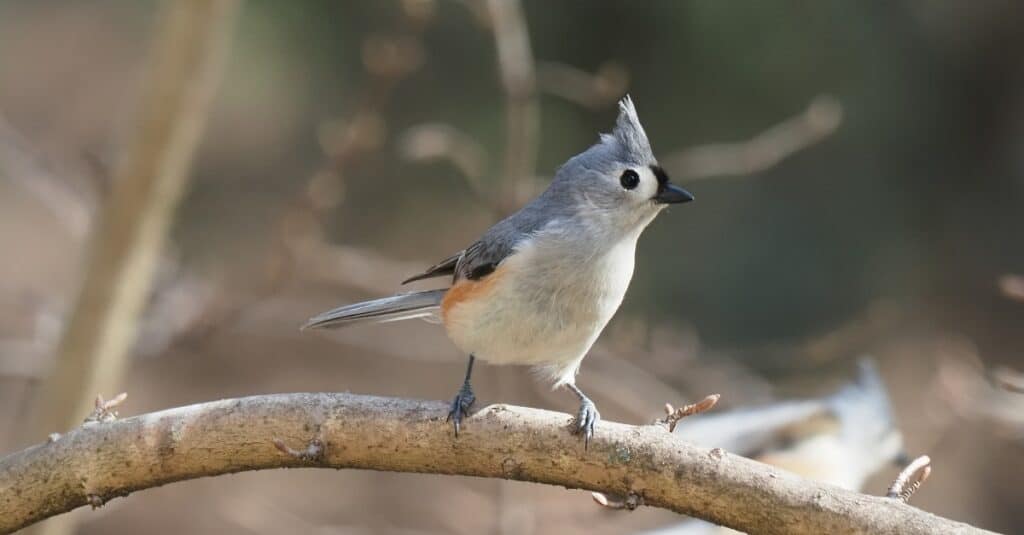
They are considered among the smartest bird species after corvids (crows and jays) and parrots.
©iStock.com/Tongtong Chen
The tufted titmouse is a small bird with a soft silvery gray color above and white below, with a peach or rusty hue down its flanks. It has a black patch just above its bill, which gives it a snub-nosed appearance. These birds are skilled foragers. They can do acrobatic movements in their search for food in West Virginia.
The tufted titmouse is typically around 5 to 6 inches long and resides in deciduous or mixed evergreen-deciduous woodlands. They prefer areas with a dense canopy and a wide variety of tree species. Their diet consists mainly of insects and seeds.
Titmice are intelligent creatures with high adaptability. They are the smartest bird species after corvids (crows and jays) and parrots.
Common Grackle (Quiscalus quiscula)
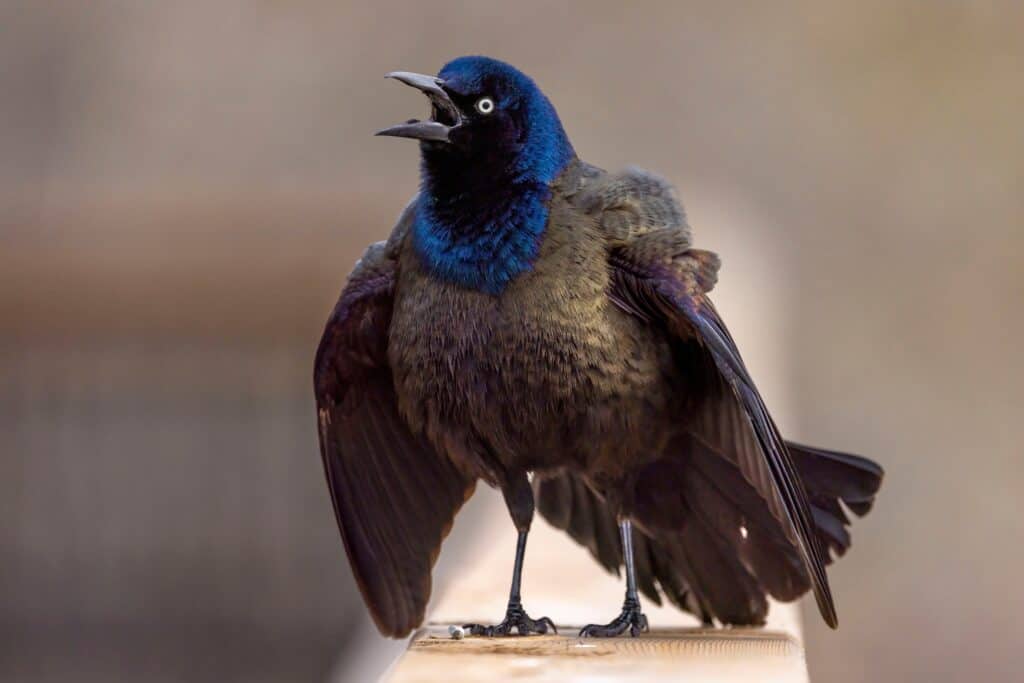
The common grackle is a New World blackbird, measuring 11 to 13 inches and weighing 2.6 to 5 ounces, with a 14 to 18-inch wingspan.
©Kendall Collett/Shutterstock.com
Common grackles thrive in West Virginia, where they rank as the third most commonly sighted blackbird.
These birds have a distinct appearance: long legs, long tails, and flat heads. They possess a longer bill than most other blackbirds, with a slight downward curve. Adult common grackles usually measure between 11 to 13 inches in length.
Common grackles inhabit various environments, including marshes, wet and open woodlands, suburbs, and agricultural fields. Their diet comprises invertebrates and mice, which they catch by following plows. They can also catch small fish, pick leeches off the legs of turtles, and raid nests. They occasionally steal worms from American Robins, killing and consuming adult birds.
Cooper’s Hawk (Accipiter cooperii)

This hawk flourishes in several habitats as a forest-dwelling specie.
©J. S. Fisher/Shutterstock.com
Throughout the year, Cooper’s hawks, which are amongst the most adept fliers among birds, can be spotted in West Virginia. These medium-sized hawks measure around 14 to 20 inches. The adult Cooper’s hawk displays a grayish-blue back and a white underbelly with reddish-brown stripes. Their head adorns a black cap, and their tail has three black bands.
Cooper’s hawk flourishes in several habitats as a forest-dwelling species, including mixed and deciduous forests, small woodlots, open woodlands, and mountainous areas. They eat a mixed diet of small and medium-sized birds, reptiles, fish, and small mammals like mice.
While hunting, Cooper’s hawks seize their prey with their feet and kill it through repeated squeezing. Reports indicate that they may even submerge birds underwater until they stop moving.
Red-Winged Blackbird (Agelaius phoeniceus)
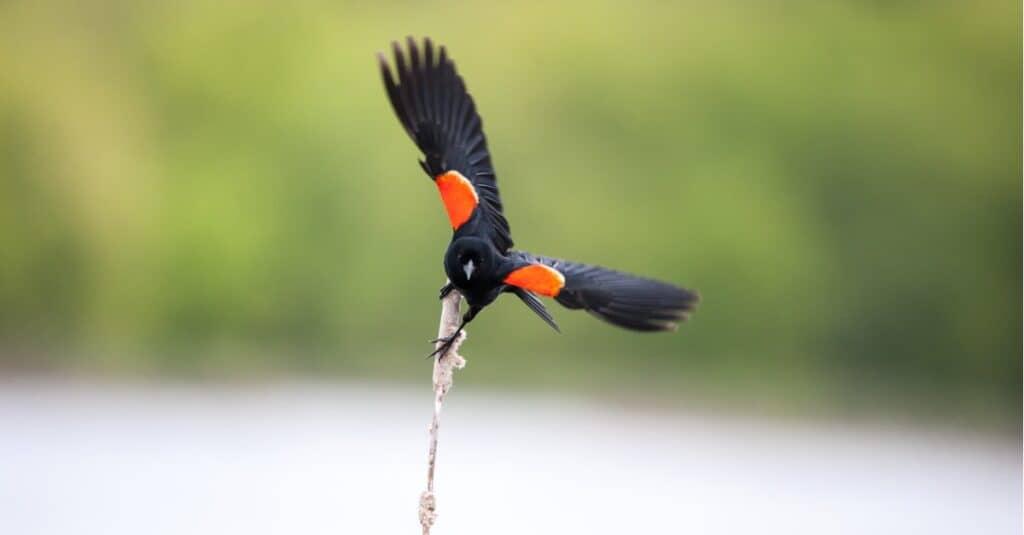
The shoulder feathers of the red-winged blackbirds are incredibly unique.
©iStock.com/maiakphotography
These eye-catching birds thrive in the summer in West Virginia and are the second most spotted during winter.
Male red-winged blackbirds are identifiable by their glossy black feathers and yellow-and-red shoulder badges. At the same time, female birds have crisp streaks and a dark brownish color with a lighter shade on their breast and may also display a whitish eyebrow. These birds are approximately 9 inches in length.
Red-winged blackbirds can be found in various habitats, such as freshwater and saltwater marshes, wet roadsides, and along watercourses. Their diet primarily consists of seeds, waste grains, small fruits like blackberries, insects, and spiders.
This bird species is highly polygamous, with a single male potentially having up to 15 different females nesting within its territory.
Red Crossbill (Loxia curvirostra)

The red crossbill has a unique beak, allowing it to open food sources easily.
©iStock.com/bobloblaw
Red crossbills have been observed in West Virginia for more than a century. These intriguing finches are typically found in coniferous woodlands and are identifiable by their brick-red coloration in adult males and yellowish-brown hues in females. These birds range in size from 5 to 7.5 inches, with immatures possessing a brownish color above and pale underparts with brownish streaks.
Red crossbills are notable for their feeding behavior. They primarily forage on nutritious seeds from pine, hemlock, and spruce cones and tend to nest wherever there is an ample food supply, even in the winter season.
Interestingly, the oldest recorded red crossbill was over 16 years old, indicating that these birds can have a relatively long lifespan.
Evening Grosbeak (Coccothraustes vespertinus)
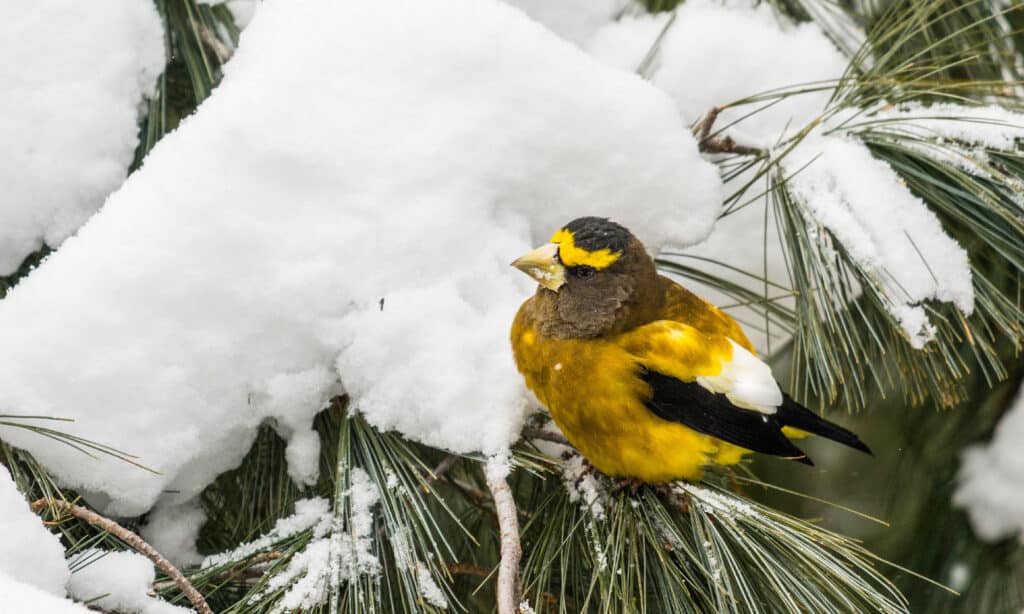
Because of their size and flocking behavior, evening grosbeaks are more likely to utilize platform feeders rather than tube feeders.
©Guoqiang Xue/Shutterstock.com
The evening grosbeak is a bird species distinguished by prominent white patches in their wings, adult males featuring yellow and black feathers, and a yellow stripe above their eyes and dark heads. Females and younglings have mostly gray feathers with black and white wings and a greenish-yellow shade on their necks and flanks.
These birds measure approximately 6 to 9 inches and are typically found in coniferous forests up north, occasionally venturing into West Virginia during winter in search of food. They primarily feed on sunflower seeds but also consume berries, and buds from trees and shrubs, with a particular preference for maples.
Because of their size and flocking behavior, evening grosbeaks are more likely to utilize platform feeders rather than tube feeders.
Bufflehead (Bucephala albeola)
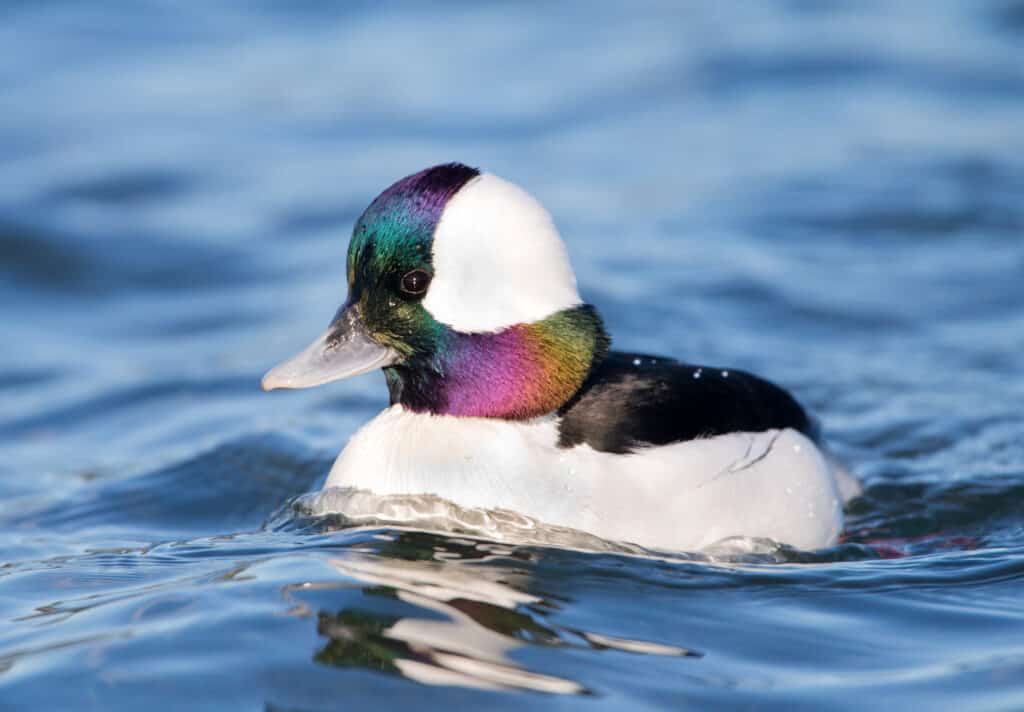
The peak of the bufflehead migration is in November.
©Birdiegal/Shutterstock.com
One can spot the bufflehead bird species during the winter season in West Virginia. These birds are usually seen from October to April, while some of them remain until June.
Bufflehead males are quite easily identifiable due to their striking white patches situated behind their eyes. The patch accentuates the green and purple sheen on their crown, forehead, neck, and throat. These birds have a black upper half and a white bottom half, and they measure around 13 to 14 inches in length.
In contrast, the female buffleheads look entirely different from their male counterparts, except for their round heads. Their heads are dark brown or black with a white patch located below their eyes. These birds have a gray bottom half and a black top half.
Poplar and aspen forests surrounding small ponds and lakes are the favored habitats of the bufflehead. These birds mostly dive when searching for food and consume mollusks, crustaceans, and aquatic insects underwater. Additionally, they do not communicate with loud calls and are generally silent birds.
Pine Siskin (Spinus pinus)
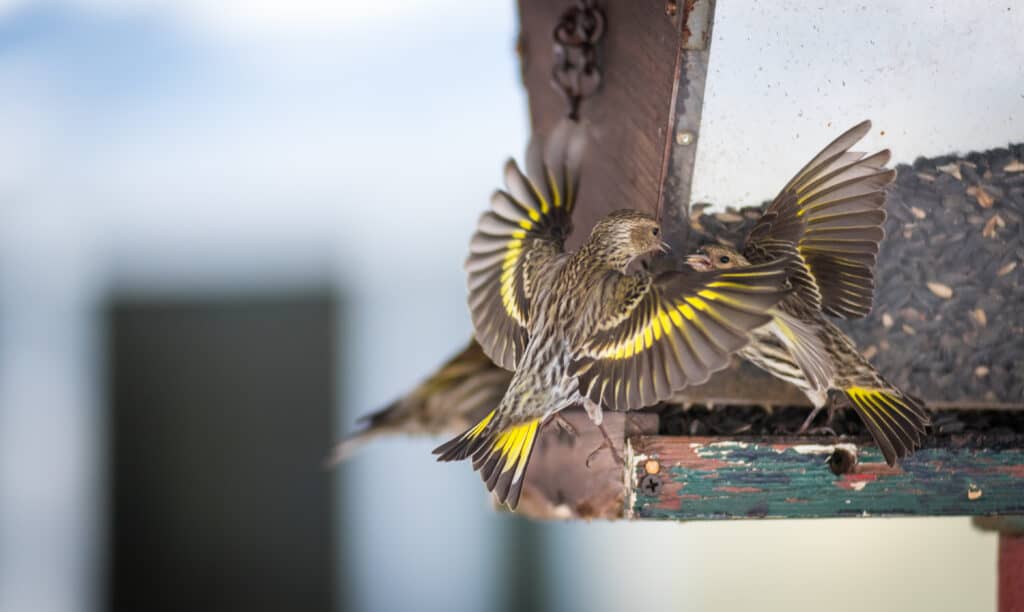
Pine siskins have a wingspan of 7.1 to 8.7 inches.
©valleyboi63/Shutterstock.com
The tiny bird species are found in West Virginia. They have slender, pointed beaks and short, notched tails, and their bills are more delicate than most finches. When flying, they exhibit forked tails and sharp wingtips.
These small birds are streaky brown in color, with subtle yellow highlights on their tails and wings. The yellow flashes become visible when they flutter at branch tips, show off during mating rituals or take flight. They measure between 4 to 5.5 inches in length.
Pine siskins prefer to nest in open coniferous or mixed forests but can also be found in cemeteries, suburban woodlands, and parks. They are attracted to nyjer, thistle feeders, and other small seeds like hulled sunflower or millet seeds.
Red-Shouldered Hawk (Buteo lineatus)
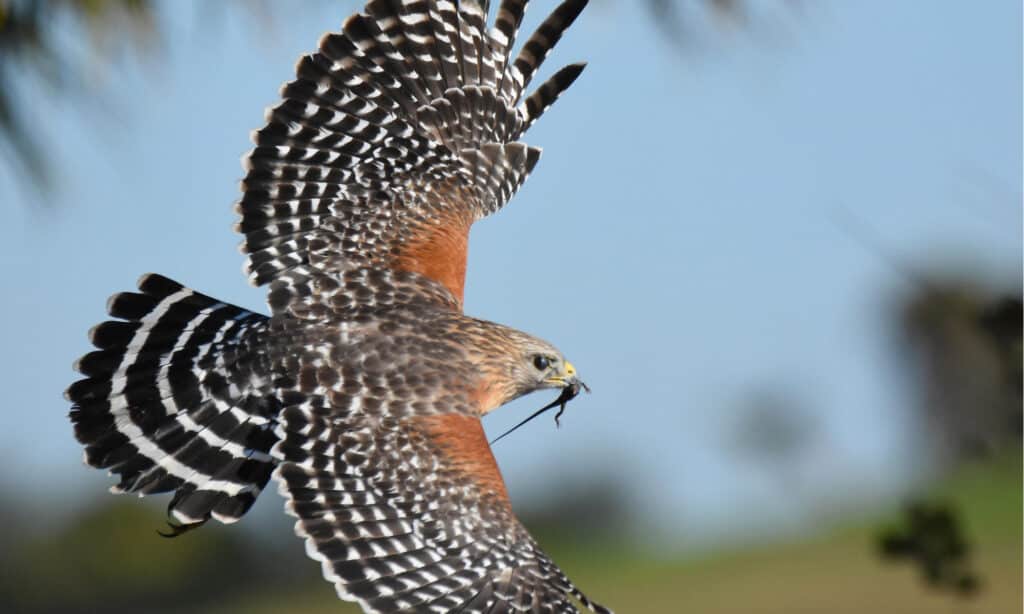
Adult red-shouldered hawks have a very rich, red coloration on their “shoulders” and chest.
©MTKhaled mahmud/Shutterstock.com
These fearless hunters are year-round residents in West Virginia. They have brown heads and backs, reddish chests, rufous patches on their shoulders, and flight feathers with black and white colors. Their tails have black hues with multiple slim white stripes.
Young red-shouldered hawks are primarily brown on top and have cream-colored underparts with brown streaks. The male species measures between 15 and 23 inches long, whereas females are slightly larger, ranging from 19 to 24 inches.
The preferred habitat of red-shouldered hawks is forest adjacent to streams, swamps, marshes, and rivers. They are omnivorous birds, meaning they feed on a wide range of prey, such as amphibians, reptiles, birds, and mammals.
Red-shouldered hawks exhibit site fidelity, meaning they return to the same general nesting area yearly.
Summary of the 13 Most Beautiful Birds in West Virginia
| Number | Beautiful Bird |
|---|---|
| 1 | American Coot |
| 2 | American Goldfinch |
| 3 | Belted Kingfisher |
| 4 | Downy Woodpecker |
| 5 | Tufted Titmouse |
| 6 | Common Grackle |
| 7 | Cooper’s Hawk |
| 8 | Red-Winged Blackbird |
| 9 | Red Crossbill |
| 10 | Evening Grosbeak |
| 11 | Bufflehead |
| 12 | Pine Siskin |
| 13 | Red-Shouldered Hawk |
The photo featured at the top of this post is © J. S. Fisher/Shutterstock.com
Thank you for reading! Have some feedback for us? Contact the AZ Animals editorial team.






